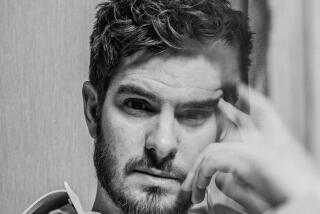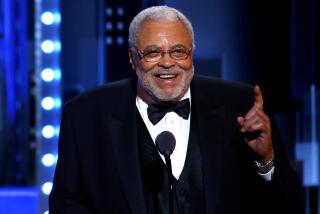The Man of a Thousand Faces
How do you prepare to celebrate a 90th birthday? How should one mark the culmination of nine decades on this madly whirling sphere? You could lie in bed, pull up the covers and thank God you made it. Or you could reminisce with anyone old enough to have taken the long trip with you (good luck). A party is always an option.
The Old Man, though, will do what he always has done and what, seemingly, he always will do. He will work. He will work until the day he turns 90 next month and probably on that day, too. He will work until he looks 70, sounds 50 and feels . . . who knows? Ageless? * About the time the rest of us are cradling a third cup of coffee, the Old Man will be preparing for the job. He’ll pack up the pickup, throwing in a crumpled gym bag with a few odds and ends.
He will be transported in more than the physical sense. By the time he arrives at the job site, he will not be my Old Man or anyone else’s, not of this world anyway.
He will be “Pops,” World War II veteran, feisty curmudgeon and operator of a diner in a mythical desert in a movie starring Jean-Claude Van Damme. If he has the time, between shooting, he’ll hurry back closer to his Malibu home, to Topanga’s Theatricum Botanicum, to play Giles Corey in “The Crucible.” * From contemporary counter man to 17th century farm
man in the blink of an eye. It will be an extraordinary 90th birthday for an extraordinary man.
Sons are supposed to feel this way, I know. But consider the life of Ford Rainey, a man who embodies the cliche: He lives to act; he acts to live.
*
On the periphery of Hollywood, where we all reside, it’s hard not to be drawn by the shimmering glamour, the overripe sensuality of celebrity. It’s heady, wonderful stuff.
As a child, it was satisfying when my friends said they had seen my father on “Get Smart” or “Wild Wild West.” In college, I could realistically promise a girl a date at the Academy Awards. (And never deliver, even though that girl is now my wife.) Being an actor’s son made me feel special.
Drama was certainly a presence in our home.
It was as immediate as the breakfast table, where the Old Man might draw on Shakespeare if my brother or sister or I failed to share, say, a slice of toast. “How sharper than a serpent’s tooth it is,” he would rail, smiling, “to have a thankless child.”
And it was as distant as a dark house after midnight--the Old Man seated with head bowed beneath a lamp, script in hand, murmuring lines to himself.
Growing up, I never would have thought of acting myself. It was a mythic undertaking for a man with a mythic past.
Born in Mountain Home, Idaho, the Old Man came from a father who was a jack-of-all-trades, local dance champion and general rapscallion.
The shy, slight boy had to be coaxed into the school play by a saintly English teacher, Miss Corbet. Once onstage, he found a release from the mundane and from himself. Soon he was touring 2003399784Chekhov, nephew of the great playwright.
Acting jobs might have been slow but, always, there was work. The Old Man picked fruit, logged tall timber, fished the Columbia River, repaired telegraph lines and busted rock with a sledge hammer. Eventually, he became a horseman and a fencer. He built a house from the ground up and earned his carpenter’s license.
You don’t have to act it, so much, if you’ve lived it. He lived it.
He worked through the Depression and found his way, after the Coast Guard and the war, to an apartment over the Santa Monica Pier carousel. Charlie Chaplin and Christopher Isherwood came to parties. Later, a friend named Will Geer helped him avoid the blacklist. He kept working. The Old Man made more than his share of movies. His first was alongside James Cagney, who played the mama-fixated hoodlum in the classic “White Heat.” He held a grudge against fellow sailor Steve McQueen in “The Sand Pebbles.” On television, he was guardian to the “Bionic Woman,” and, last year, an old crank in the sitcom “Ned & Stacey.”
In between, he rode against, and with, the Cartwrights, pleaded for help from the “Mod Squad,” harrumphed for air strikes as a “M.A.S.H.” general.
He had the craggy face to play a Western bad man, the gravitas (and bushy eyebrows) to portray a judge and the youthful insouciance of a Shakespearean clown.
Though classically trained, he was flexible. The avant-garde director Robert Wilson auditioned the Old Man for King Lear, forcing him to play one scene on his back and another talking to a pile of crumpled newspaper.
He made it work so well that Wilson hugged him and said, “You are a wonderful man.”
*
It’s the stage, really, that has defined the Old Man’s life. Not because he holds any pretense about the sophistication of “the thee-taah.” It was simply the place with the meatiest roles--the pure, elemental thing.
I can remember visiting many a cramped backstage, choked with the odor of pancake powder, spirit gum and sweat. Half-naked bodies shimmied out of costumes. Whether at the Music Center or a 50-seat theater in Hollywood, there was an air of expectation, of possibility.
When he was young, after the war, the Old Man and some Chekhov associates created a farm and a theater. The “Ojai Valley Players” cared for horses and vegetables by day, played “MacBeth” by night. John Huston and others came from Hollywood to root on the young bohemians.
The theater gave him so much. It introduced him to a radiant young actress from Santa Barbara named Sheila Hayden, who became his wife and life’s love for the past 44 years.
Fifteen years past “retirement” age, the Old Man was still at it. In one stretch in the 1980s he shuttled, in three days, between three Los Angeles stages--from a one-night reading of Ezra Pound, to a final performance as Wilson’s King Lear, to a matinee of “Twelfth Night.”
Not long afterward, he became the vituperative old Dodge in Sam Shepard’s “Buried Child,” maybe the greatest role of his life. The Boston Globe called him “brilliant” and “moving.”
In the theater, the workman and craftsman and artist in the Old Man could come together like nowhere else. He sometimes made his costumes and kept his own wigs, so they would be just right. On the stage, his training and his discipline would come to the fore, like an Abstract Expressionist who reaches greatness because in his youth he learned to draw.
The lessons translated to film, television and life.
The Old Man likes to recall how Cagney, before filming a train robbery scene, brought his hand to his chin and told the cast: “Let’s get up. Let’s bring it up here.”
To him that meant enhancing the energy, creating a heightened experience for the actors and the audience. Making something bigger than life. My parents once went to a swami or a yogi, or some such, to learn how to meditate. At the very first session, the Old Man was on the breath, quieting his mind like a Zen master. The yogi studied him and pronounced: “He should be teaching the class.”
Not long ago, some kids walked past my parents’ rambling ranch house in a dry, sagebrush-choked canyon. They paused to watch the Old Man fiddling with his beehives, or maybe it was his homemade solar heater. “The Wizard,” they called him.
That’s really a lot closer to the mark than “Old Man.”
Just pushing 40, it’s not easy to picture myself carrying on for five more decades. When I try to visualize my 90th birthday, I see well-wishers crowding to the side of my overstuffed armchair. Tearful tributes. Or the solitude of some secluded beach, reading a book under the palms.
Not bad.
But my dad has given me another option to consider. Now I also can see myself, stiff and gray, huddled over a keyboard in the year 2049, happily clattering toward my next deadline.
More to Read
Only good movies
Get the Indie Focus newsletter, Mark Olsen's weekly guide to the world of cinema.
You may occasionally receive promotional content from the Los Angeles Times.











